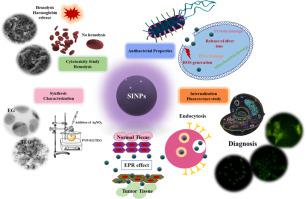Journal of Inorganic Biochemistry ( IF 3.9 ) Pub Date : 2020-08-01 , DOI: 10.1016/j.jinorgbio.2020.111177 Sofia G Nikolopoulou 1 , Nikos Boukos 2 , Elias Sakellis 2 , Eleni K Efthimiadou 1

|
Recently, there has been ongoing research in the field of nanotechnology and nanomedicine aiming at developing multifunctional biomaterials using noble metals. The unique properties of silver (Ag) are known from ancient times and thus are being explored for their behavior on the nano scale. Silver shows high antimicrobial activity against different microorganisms, while modification of the surface of its nanostructures can be useful in active targeting regarding cancer treatment. During the synthetic procedure, in order to obtain a more uniform sample of silver nanoparticles (Ag NPs) with spherical morphology, a stabilizer is essential. The stabilizers used not only control the progression of the reaction, but also increases the biocompatibility of the NPs. Thus, we managed to synthesize spherical and rod-like Ag NPs via a polyol method and stabilize them with polyvinylpyrrolidone (PVP). The resulted Ag NPs were characterized morphologically with Transmission Electron Microscopy (TEM) and further confirmed by their structural characterization (FT-IR, UV–Vis, Dynamic Light Scattering (DLS) and Zeta Potential). For their biocompatibility profile, we studied their interaction with red blood cells (RBCs) through hemolysis assay and we monitored their structural alterations through SEM. The antimicrobial activity was tested with the agar diffusion disc assay for Gram negative and Gram positive microorganisms E. coli and S. aureus respectively. Nanoparticles' (NPs) internalization and localization studies in cancer cells were monitored with fluorescence microscopy in MCF-7 and U87-MG. According to our results it is worth it to investigate the potential of these nanomaterials since they can have a significant role in applications of theranostics in nanomedicine.
中文翻译:

用修饰的多元醇方法合成生物相容性银纳米颗粒,用于血红蛋白学用途:关于红细胞,内在化能力和抗菌活性的研究。
最近,在纳米技术和纳米医学领域中正在进行旨在利用贵金属开发多功能生物材料的研究。银(Ag)的独特性质自古以来就是众所周知的,因此正在对其纳米级的行为进行探索。银显示出对不同微生物的高抗菌活性,而其纳米结构表面的修饰可用于主动靶向治疗癌症。在合成过程中,为了获得具有球形形态的更均匀的银纳米颗粒(Ag NPs)样品,必须使用稳定剂。所用的稳定剂不仅控制反应的进程,而且增加了NP的生物相容性。因此,我们设法合成球形和棒状的Ag纳米颗粒通过多元醇法,并用聚乙烯吡咯烷酮(PVP)使其稳定。用透射电子显微镜(TEM)对所得的Ag NPs进行形态学表征,并通过其结构表征(FT-IR,UV-Vis,动态光散射(DLS)和Zeta电位)进一步证实。对于它们的生物相容性,我们通过溶血分析研究了它们与红细胞(RBC)的相互作用,并通过SEM监测了它们的结构变化。用琼脂扩散盘测定法测试革兰氏阴性和革兰氏阳性微生物大肠杆菌和金黄色葡萄球菌的抗菌活性分别。在MCF-7和U87-MG中用荧光显微镜监测癌细胞中的纳米颗粒(NPs)内化和定位研究。根据我们的结果,值得研究这些纳米材料的潜力,因为它们在纳米医学中的化学治疗学应用中可以发挥重要作用。



























 京公网安备 11010802027423号
京公网安备 11010802027423号